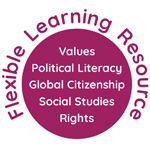Research question:
How might your sense of identity and belonging change if you were displaced?
Resources Levels 2-3
Core Activities
- Identity profile: famous person case studies, famous person profile and personal profile
- National identity: What makes you Scottish?
- Movement of people: What is it like to have no home?, Why do people move? and Movement of people Israel and Palestine
- Report
Extension Activities
- Who makes you feel safe and that you belong? My World Triangle Scotland and My World Triangle Conflict
- Movement of people: Highland Clearances
- People’s Stories case studies
- Should I Trust Everything I Read on the Web? BBC Bitesize lesson and workshee
Notes on Core Activities
Activity one: Identity profile. People are complex, we cannot be summed up by a single characteristic. This exercise from Show Racism the Red Card, lets learners consider the different aspects of the identity of some famous people and consider what makes them the person they are. Each student selects and reads a profile of a famous person and tell the others in the group what they have learned, mentioning anything they found surprising. Complete the identity profile for their case study and then one for themselves.
Activity two: National identity. Learners explore what makes them Scottish and consider the meanings in national flag.
Activity three: This activity introduces basic facts about Israel and Palestine.
The cards can be printed out and placed around the room for learners to explore to complete the activity.
Activity four: Learners watch Guardian film clip (3 mins) What is it like to have no home? And consider the different reasons that people leave their home and explore movement of people in Israel and Palestine between 1948 and 1951.
Activity five: Assessment activity. Write an informative report, using the information learned about why people move and in particular movement of people in Palestine and Israel.
Extension Activities
Activity one: Learners use the My World Triangle to consider who keeps them safe and then complete a triangle for someone living in a place of conflict. The case studies from Children Everywhere Have Rights can be used here.
Activity two: Students consider the experiences of people displaced in the Highland Clearances in this lesson from A’ Adam’s Bairns.
Activity three: Peoples’ Stories. Read the case studies. In groups, learners discuss and decide which human right fits each case study. Some people chose to stay and some to leave. Look at the reasons for leaving or staying and match to the case studies. Learners role play one case study and interview each other about their experiences.
Activity four: Students learn how to be critical about the information they find on the internet. They read the information on the BBC Bitesize web page, Should I Trust Everything I Read on the Web? Next, they should look for four websites of well-known organisations and four websites providing information on Israel and Palestine and complete the tables.
